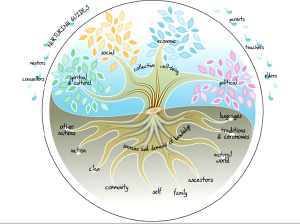Walking Together for a Better Future
Walking Together for a Better Future (Linda Kaser & Judy Halbert, 2011)
The recent introduction of Aboriginal Enhancement Agreements as part of the process of developing shared responsibility for Aboriginal Education has helped districts and community members realize the importance of working together to best meed the needs of Aboriginal learners in BC. Although signing these documents make them official, many questions have remained as to how to ensure the actions agreed to are implemented.
In 2008, the Director of the provincial Aboriginal Education Enhancement Branch approached the Network of Performance Based Schools (NPBS) to see if they were interested in developing a partnership focusing on how signed enhancement agreements could be best put into practice. This led to the development of the Aboriginal Enhancement Network of Schools (AENS) which has set about to help school districts and their Aboriginal communities in the development of cross-cultural understanding and Indigenous ways of knowing that encourage new perspectives on best practices for learning.
November 25, 2011 No Comments
The Canadian Council on Learning
The Canadian Council on Learning (CCL) website promotes and supports research on lifelong learning in Canada. Their Aboriginal section provides a variety of links to information on Aboriginal learning through videos and reports, articles on lessons in learning, as well as holistic lifelong learning models. One article in particular identifies how Aboriginal communities measuring success in learning and despite their diversity. They share a common vision of learning, which is that it is lifelong and engages all aspects of an individual including emotional, physical, spiritual and intellectual, and the community.
November 7, 2011 No Comments
First Nations Holistic Lifelong Learning
This is such a great website!
http://cli.ccl-cca.ca/FN/index.php?q=home
On this site you can explore the elements of the First Nations Holistic Lifelong Learning Model. My term project is looking at ways to support adults undertaking eLearning endeavors, so having an understanding of what a model of learning looks like for indigenous peoples is essential. I love the visuals and interactive components of the site. In the model you’ll read, “Raindrops depict learning guides such as mentors, counsellors, parents, teachers, and Elders. These individuals provide the learner with opportunities to develop mentally, spiritually, emotionally, and physically throughout the lifespan, and are an integral part of a cyclical, lifelong learning process”.
November 6, 2011 No Comments
8 Aboriginal Ways of Learning
This is a VERY short visual look at ways that allow teachers to include Aboriginal perspectives by using Aboriginal learning techniques. It is presented by “Australian Policy Online”. I liked the visual.
http://apo.org.au/website/8-aboriginal-ways-learning
October 6, 2011 No Comments
Resources for reaching out to the Aboriginal Children
http://www.aboriginalcanada.gc.ca/acp/site.nsf/eng/index.html
A collaborative site by the Canadian Government and many FN associations, this site provides information on the FN history, culture, and traditions. Besides information it provides the FN elders, women, youth, and children many activities and resources. I particularly found the links for younger children appealing where the web is used efficiently to teach the children their history, language, and the traditional way of living. Many concepts are presented in game format.
http://www.collectionscanada.gc.ca/stories/index-e.html
This site is “an exhibition celebrating stories from the oral tradition of the Inuit, Métis and First Nations peoples, from the past to the present.” It is a documentation of their oral traditional that bear witness to the cultural diversity, living history and collective knowledge from which they came.
http://www.education.gov.sk.ca/aboriginal-resource-list
This site has an exhaustive list of aboriginal resources to link with all aspects of the curriculum. Very useful guide for educators
http://www.civilization.ca/cmc/exhibitions/tresors/ethno/ety0000e.shtml
This Gateway to Aboriginal Heritage has interesting activities for children and teachers. It has rich Canadian content about traditional people and their life style. It also has lesson ideas that help students learn about aboriginal history and culture.
Indigenous Knowledge and Pedagogy
This is a very detailed paper that aims to describe and evaluate work done on indigenous knowledge and pedagogy in the First Nations education. It also explains the ethics and criteria for understanding and integrating indigenous knowledge in the classroom.
September 24, 2011 No Comments
First Nations Education Steering Committee
The First Nations Education Steering Committee is an “independent society that is committed to improving education for all First Nations learners in British Columbia. FNESC is led by representatives of First Nations across the province.” FNESC strives to facilitate First Nations support in the area of education. The website includes information about various programs and initiatives.
There are many links provided for further information. A few key ones are:
First Nations School Association
Indigenous Adult and Higher Learning Association
First Nations Early Childhood Development Council
September 21, 2011 No Comments
Learning Strategies for Aboriginal Students
Opportunities to make learning Meaningful
This document, published by Alberta Education, provides extensive suggestions for making learning meaningful for Aboriginal students. It addresses some of their unique learning attributes. Graphic organizers, cooperative learning, and independent studies are suggested, linking many important Aboriginal values and traditions to learning activities.
September 21, 2011 No Comments
First Nations Pedagogy
The mission of this website is to raise awareness of First Nations pedagogy around the world. June Kaminski, the creator of the site, provides extensive information related to Aboriginal education. The “Theory” section lists many core Aboriginal beliefs and practices (ie: story telling, the land, four directions, elders, interconnectedness). There is also an extensive list of links related to education.
September 21, 2011 No Comments


